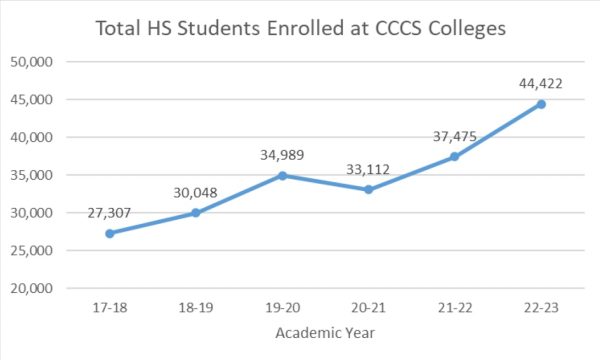After earning your high school diploma, you’re onto bigger and better things. Maybe you end up helping the state of Colorado promote its mental health services. Maybe you end up finally adding filters to your high school’s bad-tasting water fountains for future students. Or maybe, if you’re a concurrent enrollment student at Englewood High School, these are things you accomplished before you even graduated.
Concurrent enrollment students make up about 60% of Arapahoe Community College’s student headcount. That’s 9,497 students in the fall 2022 to spring 2023 school year. Through the program, high school students can take college courses for high school and college credit at no tuition cost.
At Englewood High School, Karla Shotts teaches concurrent enrollment journalism courses. In recent years, students in her photojournalism course learned to use social media and their student newspaper, The Pirateer, to do a series of stories promoting Colorado’s mental health services. They were proud of the engagement they received from people who did not know that the state provides services that could help them for free.
“When the students knew that they did something that could possibly change the lives of another person their age, it was really impactful,” Shotts said.
Like all concurrent enrollment teachers, Shotts works closely with ACC professors and liaisons to plan her classes and make sure they match college-level rigor.
“I think we ramp up the level of learning,” Shotts said. “So it’s higher-level thinking. The story selection is much more in-depth. They are harder-hitting stories where the students need to do some serious research before they write their stories [and] before they interview. And then the other piece of the puzzle is we dive deeper on certain topics.”
For high school students to learn at the college level, Shotts prioritizes being available for students to get help whenever they need it. Some students who try concurrent enrollment classes find that they might not be ready for that harder material quite yet. But for students who choose to take on the challenge, unique opportunities await.
Through another story series in Englewood’s concurrent enrollment journalism, students were able to exact real change at their school. They advocated for filters to be added to their water fountains, and the superintendent was able to make it happen. Students were able to see how their education could benefit them beyond traditional learning.

“I think it’s pushing themselves to not only learn how to be a better writer [and] learn how to be a better interviewer, but to also take any concurrent enrollment class in this campus…and know that this wasn’t just a simple high school class,” Shotts said. “[They think] ‘I pushed myself. I did better. I showed that I could be a higher-level thinker.’ And I think, overall, you can’t go wrong, whatever your outcome is, whatever your future is, if you want to be an electrician, or a plumber or go to a four-year school, those skills help you in the future.”
Fitting in
While most concurrent enrollment students take college courses at their high school, some of them take courses among college students at ACC.
Leah Olson, a Littleton High School senior, started taking courses on campus this spring through the Accelerating Students through Concurrent Enrollment (ASCENT) program in which students who complete nine college credits before graduation can receive one tuition-free year of college at ACC.
Olson currently takes cultural anthropology and interpersonal communication on campus. Despite it being nerve-racking to be younger than everyone else in her courses, she likes them more than her high school classes.
“The cultural anthropology class is very different from any other social studies class I’ve ever had,” Olson said. “The other [high school] social studies classes have been just like, study the material and get the test done.”
She appreciates being able to learn about new topics instead of the same ones that often get repeated throughout high school. And with new ways of engaging with the material, she can keep up with learning at a higher level. For any students considering concurrent enrollment, she would advise them to give it a try.
“I just say do it, it’s fun,” Olson said. “It probably is more work than they’ll expect. But at the same time, it’s less work…It’s really just reading and then a lot of in-class discussions, which is really nice to actually learn the material. But the reading is a lot more than what it was in high school.”
Francisco Torres, a junior at Sheridan High School who also takes concurrent enrollment courses at ACC, would agree that the reading is harder than in high school. He has seen a lot of his classmates struggle with the requirements of concurrent enrollment courses.
“It’s really important to train yourself to be better than you would be in high school with turning in your assignments and getting stuff done that you need to,” Torres said.
Even though the courses can be challenging, Torres also values the unique ways they can approach learning.
“I’m really enjoying my principles of criminal law class,” Torres said. “We’re doing mock trials where we’re actually acting out real court cases. Those are really interesting.”
Before starting concurrent enrollment, he was nervous about going through with it. But after getting used to his courses, he started to see attending college as a possibility.
“Just the few classes I’ve done have made me feel like it’s something I could do,” Torres said.
The big picture
Many more students have been taking advantage of these concurrent enrollment opportunities with the number of high school students enrolled at Colorado Community College System (CCCS) colleges nearly doubling in the last five years.

In the most recent academic year, out of 13 CCCS colleges, ACC had the second-highest number of high school students enrolled and the third-highest course pass rate of 94.2%.
The continuous growth of programs like concurrent enrollment has many benefits including saving high school students and their families $57 million in CCCS college tuition costs for last year’s overall attempted credit hours.
However, expanding and maintaining such a large program comes with many challenges.
“When concurrent enrollment began in 2009, in Colorado and then at ACC, it was operated as like a boutique program, but now it’s grown into like a Walmart or Target program,” Associate Dean of Concurrent Enrollment Shari Culver said. “We’re still operating it like it’s a boutique program. There has been some work to try and add some additional staff and make it a little bit more of a priority at ACC.”
One of the biggest challenges of adding staff to expand the program is that many high schools do not have enough qualified faculty who can teach college courses, which usually require a teacher to have a master’s degree in the course’s content area. This is especially difficult for high schools in lower-funded districts that cannot afford teachers with master’s degrees, which inequitably limits students’ access to opportunities.
Concurrent Enrollment Faculty Chair Monica Fuglei works with high school teachers and ACC’s liaisons to ensure they have the support and instruction they need to provide students with the best courses possible.
The extensive coordination and communication between high schools and colleges requires meticulous vigilance to ensure concurrent enrollment runs smoothly.
“We deal with multiple districts, at least four or five different school districts, and then probably over 20 high schools across those districts,” Fuglei said. “Everyone has slightly different rules, slightly different expectations, slightly different understandings of what our program is, which can lead to some real messes if you’re not super careful.”
Despite the complicated program being at high risk for error, concurrent enrollment consistently proves to be a rewarding endeavor for its participants.
A 2023 survey showed 73% of high school seniors rated their overall experience in their concurrent enrollment courses as excellent, and 91% of them planned to attend college or join the workforce within the next year.
“It’s hard,” Fuglei said. “It’s a whole bunch of different systems that we have to make fit together, but it’s the right thing to do, so I think we have a lot of people dedicated to making sure that we make it happen.”










